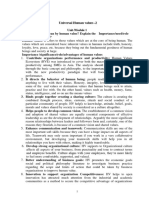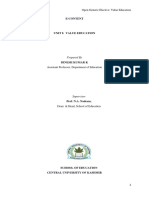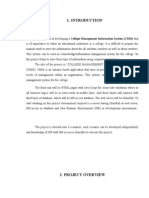0 ratings0% found this document useful (0 votes)
5 viewsUhv Unit 5 Selfmade
Uhv Unit 5 Selfmade
Uploaded by
vijaykrishna2k24Copyright:
© All Rights Reserved
Available Formats
Download as DOCX, PDF, TXT or read online from Scribd
Uhv Unit 5 Selfmade
Uhv Unit 5 Selfmade
Uploaded by
vijaykrishna2k240 ratings0% found this document useful (0 votes)
5 views4 pagesOriginal Title
UHV UNIT 5 SELFMADE
Copyright
© © All Rights Reserved
Available Formats
DOCX, PDF, TXT or read online from Scribd
Share this document
Did you find this document useful?
Is this content inappropriate?
Copyright:
© All Rights Reserved
Available Formats
Download as DOCX, PDF, TXT or read online from Scribd
Download as docx, pdf, or txt
0 ratings0% found this document useful (0 votes)
5 views4 pagesUhv Unit 5 Selfmade
Uhv Unit 5 Selfmade
Uploaded by
vijaykrishna2k24Copyright:
© All Rights Reserved
Available Formats
Download as DOCX, PDF, TXT or read online from Scribd
Download as docx, pdf, or txt
You are on page 1of 4
UHV UNIT – 5
Flowchart: Holistic Harmony Understanding Harmony
This flowchart illustrates how achieving Right Understanding leads to Natural
Acceptance and Mutual Fulfilment through the concept of Orders. This highlights
the process of aligning human actions and thoughts with natural and universal
principles for a harmonious existence.
Natural Acceptance -> Human Values
Here are some core human values that emerge from the state of natural acceptance:
1. Truthfulness: Being honest and transparent in all actions and
communications.
2. Compassion: Showing empathy and concern for others.
3. Respect: Valuing others and treating them with dignity.
4. Peace: Maintaining a state of tranquillity and harmony.
5. Love & Affection: Expressing care and warmth towards others.
6. Trust: Believing in the reliability and integrity of others.
7. Responsibility: Being accountable for one's actions and duties.
8. Humanity: Showing kindness and benevolence towards others.
9. Non-violence: Avoiding harm to others in thoughts, words, and actions.
10.Gratitude: Being thankful and appreciative of others.
Additional aspects include:
Self Verification: Continually assessing and aligning one's actions with these
values.
Understanding: Comprehending the importance and application of these
values.
Sustainability: Ensuring that actions are sustainable and do not harm the
environment or society.
Immense Happiness: Achieving a profound sense of fulfilment and joy
through living these values.
Code of Conduct for Human Beings
This code outlines essential principles to guide human behaviour for a harmonious
and fulfilling life:
1. Respect for Others: Acknowledging and valuing the rights and opinions of
others.
2. Honesty and Integrity: Being truthful and maintaining strong moral principles.
3. Responsibility & Accountability: Taking ownership of one's actions and their
consequences.
4. Kind & Compassionate: Being gentle and showing empathy towards others.
5. Fairness & Justice: Ensuring equal treatment and upholding what is right.
6. Personal Growth & Learning: Continuously improving oneself and acquiring
knowledge.
7. Environmental Protection: Taking actions to preserve and protect the
environment.
8. Humanity & Gratitude: Demonstrating kindness and being thankful.
9. Commitment to Peace: Striving to maintain and promote peace in all aspects
of life.
These topics highlight the interconnectedness and importance of values and ethics
in achieving a balanced and harmonious existence. Each value and principle acts as a
building block for a sustainable and fulfilling life, fostering mutual respect,
understanding, and well-being.
Basic for Humanistic Education
This section focuses on the principles and objectives of humanistic education,
emphasizing the development of the whole person, including their personal growth
and social responsibility.
Personnel Growth & Sense of Social Responsibility
Personnel Growth: This involves self-actualization, where individuals strive to
realize their full potential and capabilities. Personal growth includes
emotional, intellectual, and physical development, fostering a well-rounded
individual.
Sense of Social Responsibility: This is about nurturing an individual's
understanding of their role and responsibility within society. It involves
cultivating a commitment to contribute positively to the community and the
world at large.
Key Components
1. Focus on Whole Person: Humanistic education aims to develop all aspects of a
person—intellectual, emotional, social, and physical—ensuring holistic growth
and well-being.
2. Self-Actualization & Personnel Growth: Encouraging individuals to achieve
their fullest potential, recognize their strengths, and continuously improve
themselves.
3. Emotional Intelligence: Developing the ability to understand, manage, and
express one's emotions effectively, and to navigate interpersonal relationships
judiciously and empathetically.
4. Student-Centered Learning: This approach places the student at the heart of
the learning process, encouraging active participation, critical thinking, and
personalized learning experiences.
5. Intrinsic Motivation: Fostering a love for learning driven by internal rewards,
such as curiosity and personal satisfaction, rather than external incentives.
6. Respect for Individuality: Valuing and nurturing the unique qualities and
perspectives of each individual, promoting diversity and inclusion.
7. Ethical & Social Responsibility: Instilling a sense of morality and a
commitment to contributing positively to society.
8. Creativity and Self-Expression: Encouraging creative thinking and providing
opportunities for individuals to express themselves in various forms, such as
art, writing, or other creative outlets.
9. Critical Thinking & Open Inquiry: Promoting an environment where
questioning, exploration, and scepticism are encouraged, leading to deeper
understanding and knowledge.
10.Competitive Environment: Balancing competition with collaboration, where
individuals strive for excellence while supporting and learning from each
other.
These principles aim to create a nurturing educational environment that fosters
personal growth, ethical development, and social responsibility, preparing
individuals to contribute positively to society.
You might also like
- Manual Weigh SharkDocument50 pagesManual Weigh SharkJuan Carlos Palomares BeltranNo ratings yet
- Raymond - Cc-How To Remove Clear Reveal Unlock or Reset BIOS Security PasswordDocument11 pagesRaymond - Cc-How To Remove Clear Reveal Unlock or Reset BIOS Security PasswordVIC RODNo ratings yet
- Unit - I IntroductionDocument8 pagesUnit - I IntroductionABDUL HAMIDNo ratings yet
- Uhv U-1Document15 pagesUhv U-1vasumajji383No ratings yet
- UHV Draft SbuDocument73 pagesUHV Draft SburenuprasadNo ratings yet
- Peace and Values EducationDocument4 pagesPeace and Values EducationChat Aira JustinianoNo ratings yet
- 13408_MODULE 5 - UNDERSTANDING HARMONY AND ETHICAL HUMAN CONDUCT.Document12 pages13408_MODULE 5 - UNDERSTANDING HARMONY AND ETHICAL HUMAN CONDUCT.ghantidebanjanNo ratings yet
- Universal Human Values SelfDocument10 pagesUniversal Human Values SelfSano ManjiroNo ratings yet
- Pee Unit-IDocument10 pagesPee Unit-IAnonymous lZ0hmpoFNo ratings yet
- text to pdfDocument2 pagestext to pdfpallekonavamsisaikrishna881No ratings yet
- Hve Unit-1 NotesDocument45 pagesHve Unit-1 NotesShivam SharmaNo ratings yet
- Uhv 50%Document16 pagesUhv 50%shuklaji1924No ratings yet
- Module 1-Introduction to Value EducationDocument8 pagesModule 1-Introduction to Value EducationRashmi SMNo ratings yet
- Module 5Document12 pagesModule 5seemakatariaNo ratings yet
- Module 3 Leson 1 and 2 SY 2021 22Document11 pagesModule 3 Leson 1 and 2 SY 2021 22detomasnicoleerika01No ratings yet
- Human Life PurposeDocument10 pagesHuman Life PurposeRajendra raviNo ratings yet
- UHV Mid 1 Question BankDocument53 pagesUHV Mid 1 Question Bankvijaykrishna2k24No ratings yet
- Rudra 3Document11 pagesRudra 3srsxerox786No ratings yet
- HVE NotesDocument35 pagesHVE Notesrawatsumit9902No ratings yet
- Value Education Notes For ReferenceDocument45 pagesValue Education Notes For Referencejmibackup01No ratings yet
- UHV - Unit I - DescriptiveDocument11 pagesUHV - Unit I - Descriptivecontact4924No ratings yet
- Handbook Manual on Human ValuesDocument11 pagesHandbook Manual on Human ValuesSai NaliniNo ratings yet
- Human Value and Ethics Note 1Document19 pagesHuman Value and Ethics Note 1mr.rolex00.98No ratings yet
- Presentation (1)-1Document12 pagesPresentation (1)-1adityasiotra123No ratings yet
- Uhv 2mDocument11 pagesUhv 2mpallavi krishnaNo ratings yet
- UHV (1)Document15 pagesUHV (1)indhureddy444No ratings yet
- Module 3 Leson 1 and 2 SY 2021 22Document11 pagesModule 3 Leson 1 and 2 SY 2021 22detomasnicoleerika01No ratings yet
- HVE ExternalDocument33 pagesHVE ExternalGAURAV MISHRANo ratings yet
- CH 6Document27 pagesCH 6jemin DadhaniaNo ratings yet
- How To Be A Good Human BeingDocument1 pageHow To Be A Good Human BeingsnehalaroraonlineNo ratings yet
- Value Education Unit OneDocument14 pagesValue Education Unit OnereorffggjhgNo ratings yet
- Module 1 - Human ValuesDocument12 pagesModule 1 - Human ValuesAkshara Raj Xl B,15No ratings yet
- Small AnswersDocument7 pagesSmall Answersdurgareddy387gmailcoNo ratings yet
- UHV All UnitsDocument105 pagesUHV All Unitsvenkatesh.j545No ratings yet
- Nptel QuestionsDocument33 pagesNptel Questionsshwetadsinnor19No ratings yet
- Unit 1 Questionnaire UHVPDocument9 pagesUnit 1 Questionnaire UHVPrudrakashkhurana17No ratings yet
- I. Values Development: A. Value DefinedDocument9 pagesI. Values Development: A. Value DefinedJohn MarcNo ratings yet
- UHV Question and AnswerDocument90 pagesUHV Question and Answermaneeshachilukuri100802No ratings yet
- Human Person and Values DevelopmentDocument11 pagesHuman Person and Values DevelopmentREIANA MITZI M. FernandezNo ratings yet
- GE 8076 Professional Ethics in EngineeringDocument11 pagesGE 8076 Professional Ethics in EngineeringragunathNo ratings yet
- UHV Unit 5 Lecture NotesDocument12 pagesUHV Unit 5 Lecture Notesbalagamdevi5No ratings yet
- Understanding The Needs 3rd SemDocument84 pagesUnderstanding The Needs 3rd SemÚdita ShNo ratings yet
- Unit 1 Q and A TypeDocument21 pagesUnit 1 Q and A TypebalaNo ratings yet
- UHV SummaryDocument5 pagesUHV Summaryworkload972No ratings yet
- PV & E - Unit 2Document6 pagesPV & E - Unit 2Anoosha HRMNo ratings yet
- Universal Human Values IiDocument53 pagesUniversal Human Values Iiakshithreddy8877No ratings yet
- UNIT-4 Social EthicsDocument6 pagesUNIT-4 Social Ethicsnetdark195No ratings yet
- Unit I Introduction To Value Education PDFDocument19 pagesUnit I Introduction To Value Education PDFMubasshir Shaikh100% (5)
- Social PhysicologyDocument6 pagesSocial PhysicologySulaiman SalehNo ratings yet
- ETHICSDocument14 pagesETHICSusal.felicityjoy.engchi.southNo ratings yet
- Human Values Ethical Practises in EngineeringDocument11 pagesHuman Values Ethical Practises in EngineeringotienoshedrickNo ratings yet
- 11th unit 8Document5 pages11th unit 8ilmajaan16No ratings yet
- UHV All Units - R 23Document96 pagesUHV All Units - R 23zyt2473No ratings yet
- HV Unit 1Document16 pagesHV Unit 1trustme77No ratings yet
- Introduction to Value EducationDocument32 pagesIntroduction to Value EducationDarshan H RNo ratings yet
- MODULE in ETHICS-4 Universal ValuesDocument6 pagesMODULE in ETHICS-4 Universal Valuesiamysaaahhh80% (5)
- Chapter 3 Human Person and Values DevelopmentDocument51 pagesChapter 3 Human Person and Values DevelopmentPercival Labog0% (1)
- HVPE UNIT-1&2 PYQsDocument4 pagesHVPE UNIT-1&2 PYQsAnimesh MudgalNo ratings yet
- NSTP CWTS Lk2-NotesDocument4 pagesNSTP CWTS Lk2-NotesLieu Hiel MalabasNo ratings yet
- 1) Basic Guidelines For Value Education and Its NeedDocument3 pages1) Basic Guidelines For Value Education and Its Needreddysaicharanya123No ratings yet
- Wa0017.Document6 pagesWa0017.Rahul AgarwalNo ratings yet
- HydroBall Operational ManualDocument12 pagesHydroBall Operational ManualpostboxsgNo ratings yet
- Pump Pipe Line Size CalculationDocument3 pagesPump Pipe Line Size CalculationbharathNo ratings yet
- Lab Practice: 1. Create Folder, Rename Folder, Delete Folder - 1.1. Create Hierarchical Folder Like This On Drive CDocument16 pagesLab Practice: 1. Create Folder, Rename Folder, Delete Folder - 1.1. Create Hierarchical Folder Like This On Drive CTú NguyễnNo ratings yet
- D5A Ta: Volvo Penta Inboard DieselDocument2 pagesD5A Ta: Volvo Penta Inboard DieselTerah Pio100% (1)
- Exchange of Information Between Fragrance Suppliers and Cosmetic Manufacturers - 2011Document11 pagesExchange of Information Between Fragrance Suppliers and Cosmetic Manufacturers - 2011klaudiakuNo ratings yet
- RSCH2300 Q1 ExamDocument4 pagesRSCH2300 Q1 ExamKarl JimenezNo ratings yet
- Sow English Year 1 2021Document12 pagesSow English Year 1 2021Sabrina SabriNo ratings yet
- Design Manual For Pitched Slope ProtectionDocument298 pagesDesign Manual For Pitched Slope ProtectionshimantNo ratings yet
- Model Railway Signal ProjectDocument1 pageModel Railway Signal Projectvinaykumarverma21No ratings yet
- Principle of Management LeadershipDocument8 pagesPrinciple of Management Leadership41033No ratings yet
- Monografia Usp Fingolimod HydrochlorideDocument2 pagesMonografia Usp Fingolimod HydrochloridetrinizabelNo ratings yet
- HiPer HR Owners ManualDocument85 pagesHiPer HR Owners ManualHAFIZATUL IzanNo ratings yet
- Induction MotorDocument52 pagesInduction MotorRahul sandireddyNo ratings yet
- Product and Company Identification: Safety Data SheetDocument6 pagesProduct and Company Identification: Safety Data Sheetrafael_figueroa100% (1)
- Jeemain - Ntaonline.in Frontend Web Advancecityintimationslip Admit-CardDocument5 pagesJeemain - Ntaonline.in Frontend Web Advancecityintimationslip Admit-Cardyamhham05No ratings yet
- Wind PostsDocument8 pagesWind Postsrmc_sheevakumarNo ratings yet
- Third Eye PosterDocument1 pageThird Eye PosterZulaika AliNo ratings yet
- College Managment Information SystemDocument25 pagesCollege Managment Information System9096308941No ratings yet
- International Practical Shooting Confederation: Handgun Equipment Check ManualDocument8 pagesInternational Practical Shooting Confederation: Handgun Equipment Check Manualremi GALEANo ratings yet
- Specification Clauses Underground Drainage PDFDocument3 pagesSpecification Clauses Underground Drainage PDFMac ShaikNo ratings yet
- HT185WX1 100Document28 pagesHT185WX1 100shareatorNo ratings yet
- Confidentiality Agreement FormDocument1 pageConfidentiality Agreement FormKing JakeNo ratings yet
- Navedtra - 14239 - Ship's Serviceman 3Document266 pagesNavedtra - 14239 - Ship's Serviceman 3Someone You Know100% (1)
- Core Training EvidenceDocument14 pagesCore Training EvidenceKarol MachadoNo ratings yet
- Iso TS 22163 2017 en PDFDocument11 pagesIso TS 22163 2017 en PDFCentre For Total Quality ManagementNo ratings yet
- The Lunar Nodes - A New Reading of Its Traditional MeaningDocument17 pagesThe Lunar Nodes - A New Reading of Its Traditional MeaningLuis Alvarez100% (1)
- SURAJ PAtel FinalDocument32 pagesSURAJ PAtel FinalSACHIN kumarNo ratings yet
- Consumer Perception About Amul ButterDocument15 pagesConsumer Perception About Amul ButterDarshan C ReddyNo ratings yet

























































































